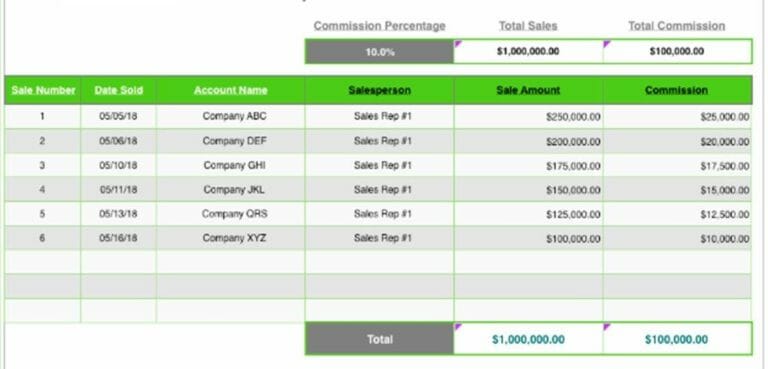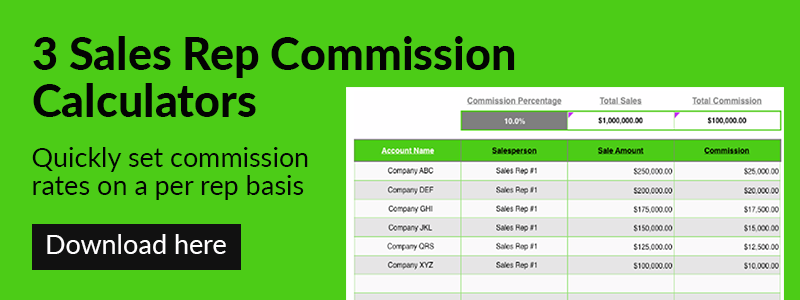Your sales commission structure is a critical piece of your company’s success. It not only determines the level of talent you can attract, but it also influences how sales reps feel valued and motivated at work. It seems straightforward—offer more money, land better salespeople, right? But the reality is more nuanced. Top-performing reps often look for both a solid base salary and fair, rewarding commission opportunities.
According to Glassdoor, as of June 2024, the average annual base pay for a U.S. Field Sales Representative is around $62,000, with an additional $53,000 in additional pay, such as commissions or bonuses. Because the commission is such a significant percentage of total compensation, the way it is structured can make or break your team’s performance.
By structuring commissions thoughtfully, you incentivize high-performance behaviors, retain skilled professionals, and align sales activities with wider business objectives. This is increasingly important in today’s hybrid and remote work environments, where compensation models must be both competitive and flexible.
Below, we’ll explore how to design an effective commission structure—and how to keep it both fair and motivating for your sales team.
What Is A Sales Commission Structure?
Sales commission is the variable component of a total sales compensation package. Companies typically define an on-target earning (OTE) as the total expected compensation when a salesperson fully meets their quota. However, the actual commission depends on each salesperson’s specific goals and performance.
Your commission structure ties sales rep performance to the amount of money they will take home each paycheck. It’s no secret that accountability produces results, and a well-structured commission plan is an excellent way to incentivize top performance.
So, while the salary component of a salesperson’s comp package is fixed and pretty easy to understand, the variable portion has a large amount of room for flexibility and configuration depending on the type of sale and sales process a company has in place.
Because there’s no one size fits all, sales compensation plans come in many different forms. Common commission structures include:
- Commission-only (“straight commission”)
- Revenue commission
- Territory volume commission
- Gross margin commission
- Draw against commission
- Tiered commission
- Residual commission
- Multiplier commission
- Variable-rate commission
- Base salary + percentage commission
Of these, the simplest, most common approach is to pay a set percentage based on the revenue generated from a single sale. For example, a sales rep who closes a deal for $500 with a commission rate of 5% earns $25 per sale.
Why it’s Important to Choose the Right Commission Structure
Your company’s sales commission plan is essential because it helps motivate reps, boost productivity, and decrease rep turnover.
Let’s talk about each of these benefits in greater detail.
Increase motivation
A well-designed sales commission plan will keep your team striving for more—more leads, more sales, and, ultimately, more money in their pockets.
Put yourself in your sellers’ shoes and ask yourself, “which plan would motivate me more? The one that pays me a set sales commission percentage, or one where the percentage increases once I close a certain amount of deals?”
Boost productivity and performance
Motivated employees are often more productive. When your reps are properly incentivized to sell more, they’ll discover the most efficient ways to work in order to maximize their time.
Decrease turnover
Lastly, the right commission structure will help you attract the best salespeople to your company and keep them for longer periods of time.
Studies show that, more often than not, employees leave organizations for one of two reasons: “personal choice” or “compensation”. You can’t do much if your top seller takes a job in Florida to live on the beach. That’s a personal choice. But you can offer attractive sales commission plans to increase the chances of retaining top sales talent.
10 Typical Sales Commission Structures (With Examples)
In this section, we’ll explore 10 different sales commission structures, highlighting when each one works best and when it might not.
Commission Only Structure (Straight Commission)
How it works: Under a Commission-Only structure, also known as a Straight Commission plan, reps receive a predetermined percentage of every sale. They do not earn a base salary, nor can they increase their commission rate over time.
Example: Sales reps earn a 25% commission per product sold. In a year, if they sell 30 products at $1,000 each, 20 products at $5,000 each, and 15 products at $10,000 each, their total commission would be $70,000.
When to use it: This approach is common for businesses hiring temporary or contract salespeople, especially those with short sales cycles and the ability to offer substantial commissions. However, most sales reps find it stressful because if no deals are closed, they earn nothing.
Revenue Commission Structure
How it works: In this model, reps earn a fixed commission every time they sell a product or service, making it simple and popular for many outside sales teams.
Example: If a company offers a $500 service with a 10% commission rate, a rep would earn $50 per sale.
When to use it: This structure is ideal for offerings with set price points and can help businesses gain market share or enter a new market, as the focus is less on profit and more on strategic growth.
Note: Revenue-based commissions often don’t align with broad, long-term organizational goals or the specific dynamics of a sales team. Implementing them without proper consideration can lead to mismatched incentives.
Territory Volume Commission Structure
How it works: Under this structure, total sales generated within a given territory are pooled, and the resulting commission is divided equally among all reps who operate there.
Example: Imagine three reps in a 100-mile region with a $75,000 quota. The first rep sells $30,000, the second sells $26,000, and the third sells $22,000. Their combined total of $78,000 exceeds the quota, so they earn a 20% commission, which is split equally—each rep receives $5,200.
When to use it: This plan thrives in collaborative, team-oriented environments where everyone works toward a shared goal, leaving little room for lone-wolf tactics.
Gross Margin Commission Structure
How it works: Similar to a revenue-based commission, a gross margin structure calculates the rep’s commission on the actual profit of a sale. Rather than using the total sale price, it subtracts the costs associated with completing the transaction, and then the sales rep’s commission is applied to the remaining profit.
Example: If your company sells a service for $1,000 but spends $500 to fulfill that service, the rep would earn a percentage of the $500 profit rather than the entire $1,000 sale price.
When to use it: Teams that prioritize profitability often prefer this approach. By tying compensation to profit rather than revenue, a gross margin commission structure ensures each sale meaningfully contributes to the company’s bottom line.
Draw Against Commission Structure
How it works: This model provides advance payments, commonly referred to as draws, ensuring reps receive a set amount each month, regardless of closed deals. In some cases, the draw is “borrowed” and must be repaid under specified terms.
Example: If a rep has a $2,000 monthly draw and earns $1,000 in commission during their first month, they keep the $1,000 plus an additional $1,000 from the draw, totaling $2,000 in compensation.
When to use it: Draw Against Commission plans are especially useful for new hires, ramp-up periods, extended transition times, and training programs.
Tiered Commission Structure
How it works: In a tiered plan, reps earn higher commission rates once they hit specific milestones, whether that’s closing a certain number of deals or surpassing a predetermined revenue threshold. This structure is especially appealing to motivated, high-performing sales reps.
Example: Reps might earn 5% on sales until reaching $10,000 in revenue; after that point, they would earn 8% on all additional sales.
When to use it: This model is highly effective for scaling a sales team. By providing higher commission rates beyond certain targets, you incentivize top performance and encourage practices like upselling and cross-selling.
Residual Commission Structure
How it works: Under a residual commission plan, reps earn commissions for as long as their acquired accounts continue to generate revenue. This incentivizes strong relationships and long-term customer retention.
Example: If a client pays $2,000 per month for your services, the rep who closed the deal would receive a 5% commission—$100 each month—for the duration of the contract.
When to use it: This model is particularly effective for organizations with recurring revenue streams, such as insurance companies or marketing agencies, where consistent renewals drive profitability.
Multiplier Commission Plan
How it works: This model combines a base commission rate with a multiplier that adjusts payouts based on how well a rep meets (or exceeds) set targets. Although it can be complex to set up, this flexibility often provides strong motivation for sales teams.
Example: Suppose a rep’s standard commission rate is 5%. It’s then multiplied by 0.8 if the rep hits under 75% of quota (resulting in 4%), 0.9 if the rep achieves 76–85% of quota (4.5%), or stays at 1 (5%) if the rep reaches 86% or more.
When to use it: This structure is particularly useful for sales leaders who want to reward performance across multiple KPIs, product lines, or upsell opportunities.
Base Pay Rate Only
How it works: With this plan, sales reps receive a fixed annual salary (with or without benefits) and do not earn any additional commission on their sales.
Example: Your organization might pay each sales rep $60,000 a year—roughly $1,150 per week—regardless of performance.
When to use it: While this structure is uncommon because it offers little motivation for reps to exceed quota, it can be appropriate for companies that rely heavily on inbound leads. In these scenarios, sales reps act more like customer support professionals than traditional salespeople. However, keep in mind that a lack of incentives can lead to lower productivity over time.
Base Salary + Commission
How it works: In this model, reps receive both a base salary (or hourly wage) and a percentage of the revenue they personally generate. It creates mutual responsibility: the company invests in reps by offering a guaranteed income, while reps have a strong incentive to close deals and boost their earnings through commissions.
Because the salary portion covers a portion of reps’ income, the offered commission rate might be lower than in a pure commission model. However, there’s typically more overall earning potential for sales reps—and it’s crucial to keep commissions uncapped for maximum motivation.
Example: An organization might pay each sales rep a $40,000 annual salary, plus a 3% commission on every individual sale.
When to use it: A Base + Commission plan is ideal for companies aiming to attract top sales talent and that have the product, reputation, and infrastructure to support high performers. Offering a guaranteed income and open-ended commission is one of the best ways to show reps you believe in their success.
Other Common Sales Commission Plans
Flat-Rate Sales Commission Plan
- How it works: A rep earns a fixed amount for every product or service sold.
- When to use it: Ideal for straightforward sales cycles or when each product has similar value.
Relative Sales Commission Plan
- How it works: Reps are paid based on the percentage of their quota they achieve, rather than on total revenue. They will typically also receive a base salary.
- When to use it: Suitable for teams where meeting or surpassing targets is more important than the absolute dollar amount generated.
Split Sales Commission Plan
- How it works: Multiple departments or reps share the commission on a single deal.
- When to use it: Encourages cross-functional collaboration by rewarding team contributions rather than strictly individual efforts.
Download Our Free Commission Calculator

How to Choose the Right Sales Commission Structure For Your Sales Team
Selecting the right sales commission structure isn’t one-size-fits-all. What works for one organization might fail for another. To figure out the best option for your business, follow this six-step process:
Step 1: Determine company goals and priorities
Start by clarifying your objectives. Are you aiming to expand into new territories, reduce expenses, or close a few high-value deals? Identifying your top priorities will guide you toward the commission plan that best supports those goals.
Step 2: Benchmark against industry commission rates
Once you have a general structure in mind, decide on actual commission rates. Research your competitors to see what they pay. Offering a rate that’s too low risks losing talent, while matching or exceeding industry norms can help attract strong performers.
Step 3: Consider roles and responsibilities
Sales reps, sales managers, and specialized roles (e.g., account executives vs. new business hunters) often require different compensation plans. Tailor your commission structure to each role so that individuals are rewarded fairly for their unique contributions.
Step 4: Factor in turnover rates
A high turnover rate could indicate that your current plan doesn’t provide enough stability or compensation. Commission-only models, for example, can create stress if reps feel their earnings are unpredictable.
Step 5: Look at productivity levels
If your team has both high and low performers, consider a tiered structure to reward top producers and push underperformers to improve. Money is a powerful motivator, so offering increased commission after reaching specific sales thresholds can encourage better results.
Step 6: Consider what worked in the past
Review historical data on your existing and previous commission structures. Talk to your reps about what they liked and disliked. Beyond motivation, make note of any stress-inducing factors so you can avoid repeating those mistakes.
Step 7: Run OTE simulations
Finally, calculate your On-Target Earnings (OTE)—the total rep compensation once a specific goal is reached. This includes base pay, commissions, and other incentives. Check if that figure is both affordable for your company and competitive in your industry. If it’s not, revisit and adjust your plan until it’s sustainable and appealing.
Additional Considerations & Best Practices for Commission Structures
Legal & Compliance
Minimum Wage Laws: In some regions, your compensation plan must ensure employees earn at least the state or federal minimum wage.
Commission Agreements: Have written agreements that specify rates, timelines, and dispute resolution to prevent misunderstandings.
Automated Tracking & Reporting
Implement software solutions (e.g., CRM platforms that integrate with commission apps) to automate calculations and reporting. Clear, transparent metrics reduce the possibility of disputes and enhance sales rep trust.
Retention & Motivation
Long-Term Incentives: Consider bonuses, equity, or other rewards to incentivize loyalty. These methods foster a sense of ownership and align the rep’s success with the company’s objectives.
Professional Development: Training, mentorship, and skill-building opportunities can also help your reps feel invested in their growth, translating to higher performance.
Regular Performance Reviews
Commission structures aren’t “set it and forget it.” Schedule periodic reviews to ensure that the compensation plan remains competitive, aligns with market rates, and continues driving desirable sales behaviors.
Communication & Transparency
Straightforward Commission Formulas: Provide real-life examples of how to calculate commissions, so reps know exactly what to expect with each deal.
Open-Book Approach: Encourage ongoing dialogue about target adjustments, territory shifts, or new product lines to maintain fairness and clarity.
Which Sales Commission Structure is Right for Your Business?
The commission structure you choose has a direct impact on sales rep motivation, productivity, and turnover. You can implement one of the ten structures discussed, or combine elements to design a hybrid plan tailored to your team’s unique needs.
Above all, remember the value of strong incentives. The more you invest in your sales team’s success, the more they’ll invest in driving results and revenue for your organization. By balancing clear goals, fair compensation, and achievable targets, you’ll create a sales commission structure that supports both individual performance and company growth.



